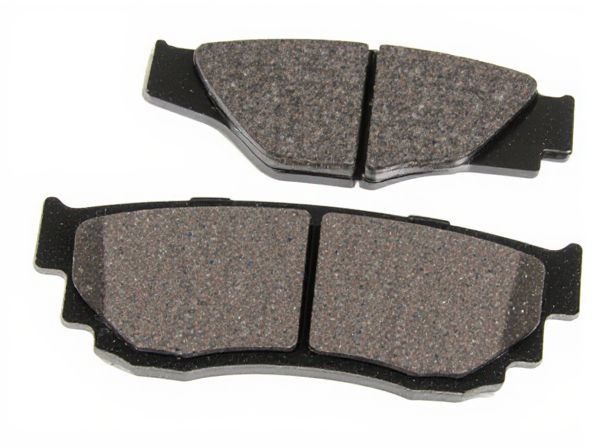
Photo illustration: High-Friction Pads vs Low-Friction Pads
High-friction pads provide superior grip and braking performance, making them ideal for demanding conditions where stopping power is crucial. Low-friction pads offer smoother operation and reduced wear, which can extend the lifespan of braking components in everyday driving. Understanding your vehicle's requirements can help you choose the right pad to balance performance and durability.
Table of Comparison
| Feature | High-Friction Pads | Low-Friction Pads |
|---|---|---|
| Friction Level | High friction for strong stopping power | Low friction for smoother, gentler braking |
| Brake Performance | Superior in emergency stops and heavy vehicles | Best for everyday driving and reduced noise |
| Wear and Tear | Higher wear rate, needs frequent replacement | Longer lifespan with less brake disc wear |
| Heat Resistance | Excellent heat dissipation for intense use | Moderate heat resistance, prone to fade under stress |
| Noise Level | Can produce more noise due to friction | Quieter braking experience |
| Cost | Generally more expensive due to material quality | More cost-effective for regular driving |
Introduction to Friction Pads
Friction pads play a crucial role in braking systems by converting kinetic energy into heat through friction, enabling the vehicle to slow down or stop. High-friction pads offer greater stopping power and improved performance under extreme conditions but may wear faster and produce more noise. Low-friction pads provide smoother braking with reduced wear and heat generation, enhancing safety and efficiency in everyday driving scenarios.
Understanding High-Friction Pads
High-friction pads are designed with materials that maximize grip and surface adhesion, making them essential for applications requiring enhanced traction and control, such as in braking systems or heavy machinery. These pads often use composites like rubber compounds or specialized polymers to increase coefficient of friction, resulting in improved safety and performance under high-stress conditions. Their durability and heat resistance further contribute to effective energy dissipation and reduced wear during intensive use.
Key Features of Low-Friction Pads
Low-friction pads are designed with materials such as PTFE or composite polymers that significantly reduce resistance between moving surfaces, enhancing efficiency in mechanical systems. These pads offer improved wear resistance and thermal stability, making them ideal for high-speed applications and environments with limited lubrication. Their low coefficient of friction minimizes energy loss and helps extend the lifespan of machinery by reducing heat generation and material degradation.
Performance Comparison: High vs Low-Friction Pads
High-friction pads deliver superior stopping power and enhanced grip, making them ideal for high-performance braking scenarios and heavy-duty vehicles. In contrast, low-friction pads reduce brake noise and wear, offering smoother braking and extended pad lifespan for everyday driving conditions. Evaluating the balance between friction coefficient, heat dissipation, and wear characteristics is crucial for selecting the optimal pad type based on driving demands.
Applications for High-Friction Pads
High-friction pads are essential in applications demanding enhanced grip and safety, such as industrial machinery, automotive brakes, and climbing equipment, where preventing slip is critical. These pads provide superior traction on surfaces that experience frequent contact or environmental challenges like moisture and oil. Their durability and resistance to wear make them ideal for heavy-duty environments requiring consistent performance.
Best Use Cases for Low-Friction Pads
Low-friction pads are ideal for applications requiring smooth, controlled movement with minimal resistance, such as in conveyor systems, sliding doors, and robotic joints, where reducing wear and energy consumption is critical. These pads excel in environments with frequent motion and delicate surfaces, preserving equipment longevity and enhancing performance efficiency. Choosing low-friction pads improves operational reliability in precision machinery and reduces maintenance costs due to their ability to minimize heat generation and material degradation.
Pros and Cons of High-Friction Pads
High-friction pads provide superior stopping power and increased brake performance, making them ideal for high-speed or heavy-duty applications; however, they tend to wear out faster and generate more heat, which can lead to brake fade and increased rotor wear. These pads offer excellent grip and improved safety, especially in wet or slippery conditions, but their noise levels and dust production are typically higher than low-friction pads. Choosing high-friction pads often means balancing enhanced braking efficiency with shorter lifespan and higher maintenance costs.
Benefits and Drawbacks of Low-Friction Pads
Low-friction brake pads offer reduced heat generation and less wear on rotors, enhancing overall component longevity and fuel efficiency. However, these pads may provide less stopping power under heavy braking conditions, potentially compromising safety performance in high-demand scenarios. Their noise levels are typically lower, but drivers might experience diminished initial bite compared to high-friction alternatives.
Factors to Consider When Choosing Friction Pads
When choosing between high-friction pads and low-friction pads, consider the specific application requirements such as the desired stopping power, heat resistance, and noise levels. High-friction pads offer superior grip and shorter stopping distances, making them ideal for performance vehicles or heavy-duty braking but may wear faster and produce more noise. Low-friction pads provide smoother braking with less noise and longer lifespan, suitable for everyday driving where comfort and durability are priorities.
Conclusion: Selecting the Right Friction Pad
Choosing the right friction pad depends on the specific application requirements, including load capacity, environmental conditions, and desired wear characteristics. High-friction pads offer superior grip and braking performance ideal for heavy-duty or performance applications, while low-friction pads excel in reducing wear and energy loss in systems requiring smooth, low-resistance movement. Evaluating factors such as coefficient of friction, temperature tolerance, and maintenance frequency ensures optimal pad selection for safety, durability, and efficiency.
 caratoz.com
caratoz.com